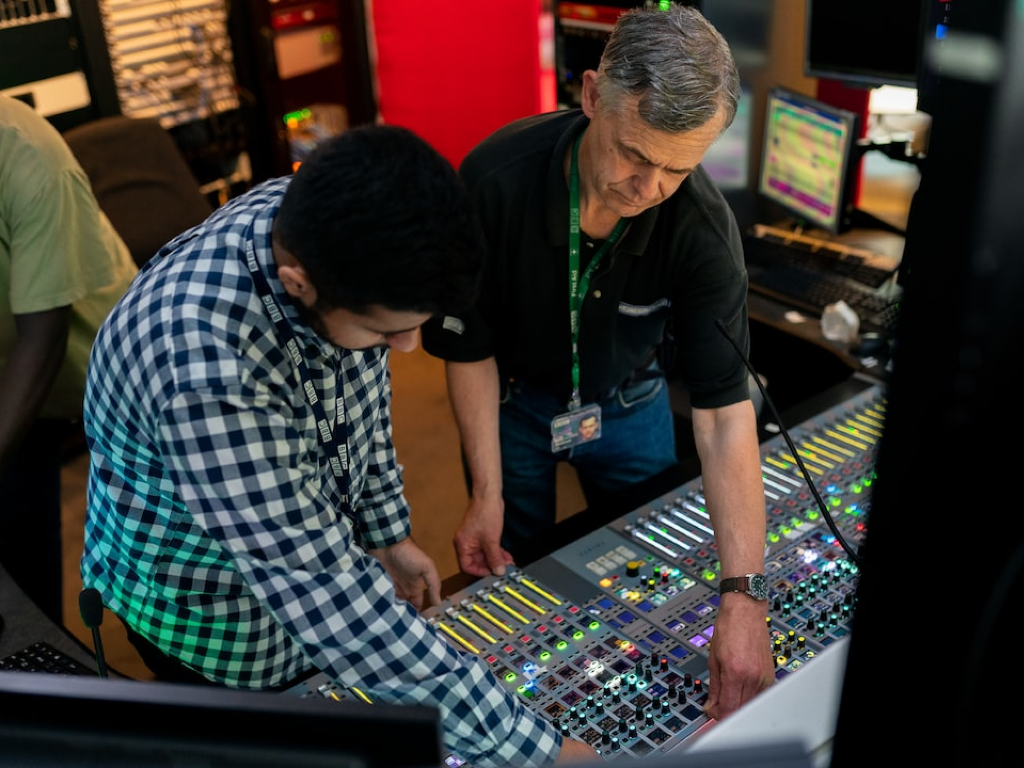Sound is crucial when it comes to creating the appropriate atmosphere, ambiance, and emotion in films. If the sound design is poorly done, viewers may completely lose interest in the film. Filmmakers use modern techniques to achieve the best possible sound quality. This article discusses these methods and the importance of good sound ambiance for the final result.
In order to create a compelling cinematic experience, sound design plays an essential role. Sound is used to evoke emotions and create an atmosphere that the audience can identify with. This enhances the visual experience and allows the audience to better identify with the characters, setting, and story. It is therefore essential to ensure that sound deliberately becomes a part of the film.
1. What are the most creative ways to improve sound in post-production
The equalizer is one of the most effective creative tools for improving post-production sound. Another way to demonstrate creativity is to use reverberation and delay effects to add a sense of space and depth. Automation can also be used to create dynamic soundscapes that move with the visuals. Finally, creative use of sound design and Foley can create a unique and engaging soundscape. We can use all of these techniques to improve sound in post-production and create an auditory experience that enhances the visual elements.
2. How do sound mixers manipulate the frequency spectrum to achieve optimal sound ?
Sound mixers manipulate the frequency spectrum to achieve optimal sound by adjusting controls to boost or reduce certain frequencies. This process is known as equalization and can be used to enhance certain sound elements while suppressing others. Mixers can use high-pass filters to reduce low frequencies and bring out the clarity of high frequencies. They can also use shelving equalizers to boost or cut the overall level of a range of frequencies. Finally, mixers can apply a parametric equalizer to boost or cut individual frequencies within a range. When used correctly, these techniques allow mixers to create the desired sound character of a track.
3. Are there any tips for manipulating sound to give it an extra touch of realism ?
Manipulating sound is an excellent way to produce realistic and highly engaging audio content. Professionals in the audio industry use various techniques, such as adding effects, to make it more natural. Additionally, it’s important to consider the context of the audio, as different sounds may be more effective in different contexts. When manipulating sound, it’s also important to experiment with different settings and levels to achieve the desired result. With the right tools and techniques, it’s possible to create realistic and engaging sound that will captivate the audience.
4. How can we use sound to make a scene more immersive and emotionally engaging ?
Sound design is essential for any production. Specialized techniques are used to generate sounds that do not exist in nature. Synthesizers are employed to create electronic sounds and set the tone, while sound effects are used to reproduce the sound of everyday objects. In addition, musical instruments can be used to create soundscapes, and audio alterations such as pitch shifting and time stretching can be applied to existing sounds. By combining these methods, sound designers can create unprecedented effects that cannot be found in nature. With the right creative approach, sound designers can create entirely original hyper-realistic effects.
Sound is a valuable tool for creating an immersive and emotionally engaging scene. The use of sound can contribute to creating an atmosphere and shaping the audience’s feelings. Music can contribute to creating a mood, while sound effects can add realism to a scene and give a tactile element to the environment. Dialogue can create a sense of belonging to a character and allow the audience to identify with them. Furthermore, the use of soundscapes can contribute to creating a sense of place and transporting the viewers to a different time and space. Used together, sound can create a powerful and lasting experience for the audience.
5. What are the new technologies used to make sound production easier and more efficient ?
Users use digital audio workstations (DAWs) to record and mix sounds from various sources, and they employ plugins such as equalizers, compressors, and reverbs to enhance sound quality, making sound production easier and more efficient in the digital age. Virtual instruments and samplers are also useful for creating soundscapes and reproducing acoustic instruments. Additionally, advancements in audio restoration software have allowed engineers to repair and remaster sound in post-production. Thanks to these new technologies, sound production has become more efficient and rational, enabling producers and engineers to quickly and easily create professional quality sounds.
6. What are the most innovative methods for recording and mixing sound on set ?
Recording and mixing sound on set is an important part of any production. With technological advancements, the possibilities for innovative methods of sound recording and mixing have multiplied. An increasingly popular innovation is the use of digital audio workstations (DAW). DAWs allow for the recording, editing, and mixing of various sound sources in a digital environment, giving filmmakers better control over the sound environment of their production. Additionally, there has been an increase in the use of hardware and software surround sound systems, providing viewers with an immersive experience. Small productions and outdoor shoots can use portable audio recorders and mixers to capture high-quality sound on set with minimal equipment, making it an ideal tool.
7. What techniques are used to make the most of a limited budget when it comes to sound ?
When working with a limited budget, there are several techniques that can be used to make the most of available resources. One of them involves prioritizing quality over quantity, by recording fewer sound sources but of higher quality, with a wider dynamic range. Another approach involves using sound layering, by combining multiple audio elements to create a more complete and immersive soundscape. An audio designer can utilize available resources and apply reverb, delay, sound effects, and sound design to simulate a larger space if physical space is not available, and to enhance the sound and give it a more professional aspect, thereby creating a high-quality soundscape on a limited budget.
8. What techniques can be used to ensure that the sound remains consistent throughout a production ?
To ensure consistent sound throughout a production, create and adhere to a detailed sound design plan. Additionally, using the same audio and video equipment throughout the production can be helpful. Constantly monitor and adjust sound levels to avoid inconsistencies caused by different equipment. Finally, perform a sound mixing session to check for any inconsistencies or potential problems and make necessary adjustments. By following these techniques, a production team can ensure that sound remains consistent throughout the production.
9. How can we use sound to create a unique atmosphere in a given scene ?
Sound is a powerful tool when it comes to creating a unique atmosphere in a scene. Thanks to sound, a director can create tension, evoke an emotional response, and build an immersive environment. For example, the ticking of a clock can increase tension in a scene, while a sad musical score can evoke an emotional response from the audience. A director can combine sound elements such as ambient noises to give the audience the feeling of being part of the scene and create a unique and captivating atmosphere. Effective reflection and planning can be used to create a distinctive atmosphere in any scene through sound.
In conclusion, every successful film requires an essential part of sound design to add depth and emotion to the storytelling, create tension and suspense, and establish atmosphere and ambiance. Professionals use a variety of techniques and approaches to ensure that a film’s sound design is as powerful and effective as possible. It is a subtle but important component of film production that can make a huge difference in the overall quality of the film.

